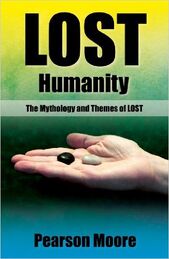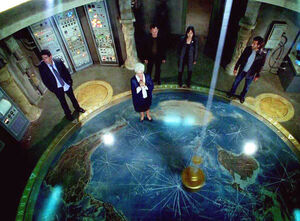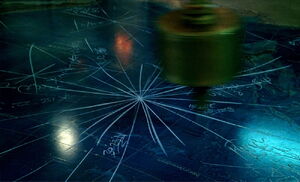(Blog post created or updated.) Tag: sourceedit |
(Blog post created or updated.) |
||
| Line 1: | Line 1: | ||
[[File:Eloiselamppost.jpg|right|300px|The Foucault pendulum used to find the Island in episode 316.]]'''The [[Dharma]] [[Lamp Post]] Station's [[wikipedia:Foucault pendulum|Foucault pendulum]] seen in [[season 5]] episode, [[316]] (used to find the Island), is much more than just a cool looking prop. There is actually some solid and compelling scientific thinking behind it.''' |
[[File:Eloiselamppost.jpg|right|300px|The Foucault pendulum used to find the Island in episode 316.]]'''The [[Dharma]] [[Lamp Post]] Station's [[wikipedia:Foucault pendulum|Foucault pendulum]] seen in [[season 5]] episode, [[316]] (used to find the Island), is much more than just a cool looking prop. There is actually some solid and compelling scientific thinking behind it.''' |
||
| − | Here I will touch on the science of why the movement of the pendulum was such a clever inclusion. When I first saw how they were finding the Island (through the use of a pendulum and Earth's own gravity), I thought it was brilliant |
+ | Here I will touch on the science of why the movement of the pendulum was such a clever inclusion. When I first saw how they were finding the Island (through the use of a pendulum and Earth's own gravity), I thought it was brilliant. |
| + | |||
| + | The swinging of the pendulum looks random but it is anything but. The actual plane of swing rotates relative to the Earth. |
||
{{Quote|text=''At either the North Pole or South Pole, the plane of oscillation of a pendulum remains fixed relative to the distant masses of the universe while Earth rotates underneath it, taking one sidereal day to complete a rotation. So, relative to Earth, the plane of oscillation of a pendulum at the North Pole undergoes a full clockwise rotation during one day; a pendulum at the South Pole rotates counter-clockwise.”'' - Wikipedia}} |
{{Quote|text=''At either the North Pole or South Pole, the plane of oscillation of a pendulum remains fixed relative to the distant masses of the universe while Earth rotates underneath it, taking one sidereal day to complete a rotation. So, relative to Earth, the plane of oscillation of a pendulum at the North Pole undergoes a full clockwise rotation during one day; a pendulum at the South Pole rotates counter-clockwise.”'' - Wikipedia}} |
||
Latest revision as of 01:45, 16 July 2019
The Dharma Lamp Post Station's Foucault pendulum seen in season 5 episode, 316 (used to find the Island), is much more than just a cool looking prop. There is actually some solid and compelling scientific thinking behind it.
Here I will touch on the science of why the movement of the pendulum was such a clever inclusion. When I first saw how they were finding the Island (through the use of a pendulum and Earth's own gravity), I thought it was brilliant.
The swinging of the pendulum looks random but it is anything but. The actual plane of swing rotates relative to the Earth.
| “ |
At either the North Pole or South Pole, the plane of oscillation of a pendulum remains fixed relative to the distant masses of the universe while Earth rotates underneath it, taking one sidereal day to complete a rotation. So, relative to Earth, the plane of oscillation of a pendulum at the North Pole undergoes a full clockwise rotation during one day; a pendulum at the South Pole rotates counter-clockwise.” - Wikipedia |
” |
A layman's translation of this is that over a period of time, a random looking swing of the pendulum actually undergoes a mathematically predictable motion in relation to the rotation of the Earth. The pendulum's location in LA places it nowhere near either of the planet's poles, so its movement there would follow a different pattern. There is no reason not to believe the Island would move around the Earth under the same law of physics.
So those white chalk marks where the pendulum says the Island "will be", actually would move on a regular basis. What a brilliant (scientifically linked) theory this is.
Anyone interested in a more detailed look into the science of the Foucault pendulum and how it works on Lost should read Pearson Moore's book "Lost Humanity". He does a great job of putting it into context in amazing detail.
There is a section in his book titled "Periodicity" in which he states that;

| “ |
Periodicity is the idea that there are certain rhythms in nature, and that outcomes tied to these rhythms are both repeating and predictable... In the context of Lost, we might refer to periodicity in literary terms: recurring motif, common theme, and so on. - Pearson Moore |
” |
He then goes on to refer specifically to the pendulum itself;
| “ |
A periodic event does not occur in random fashion. The event recurs because it experiences an outside force. In the case of a pendulum clock, the periodic motion is initiated by pulling the pendulum up and away from its equilibrium position and then releasing. Gravity acts on the weight... - Pearson Moore |
” |
Moore then charts a number of graphs and uses tried and tested scientific principles and mathematics to link the movement of the pendulum to how it works in locating the ever-moving Island on Lost. He even charts out some make-believe tracks of Rousseau's journeys across the Island over a period of time. He uses evidence from the show of how she likely would have moved around a particular area. After a while, we begin to see a pattern in her journeys. At first glance, there is nothing to see but give it time and it becomes clear. Moore then applies this same thinking to what looks like a somewhat chaotic movement of a pendulum under the forces of Earth's gravity and shows that what looks initially like chaos, is in fact not at all random
So in short - the pendulum as a writing device to tell the story of how to find this fictional Island is nothing short of genius.
Twitter: https://twitter.com/oz_greg More blog articles can be found here.


